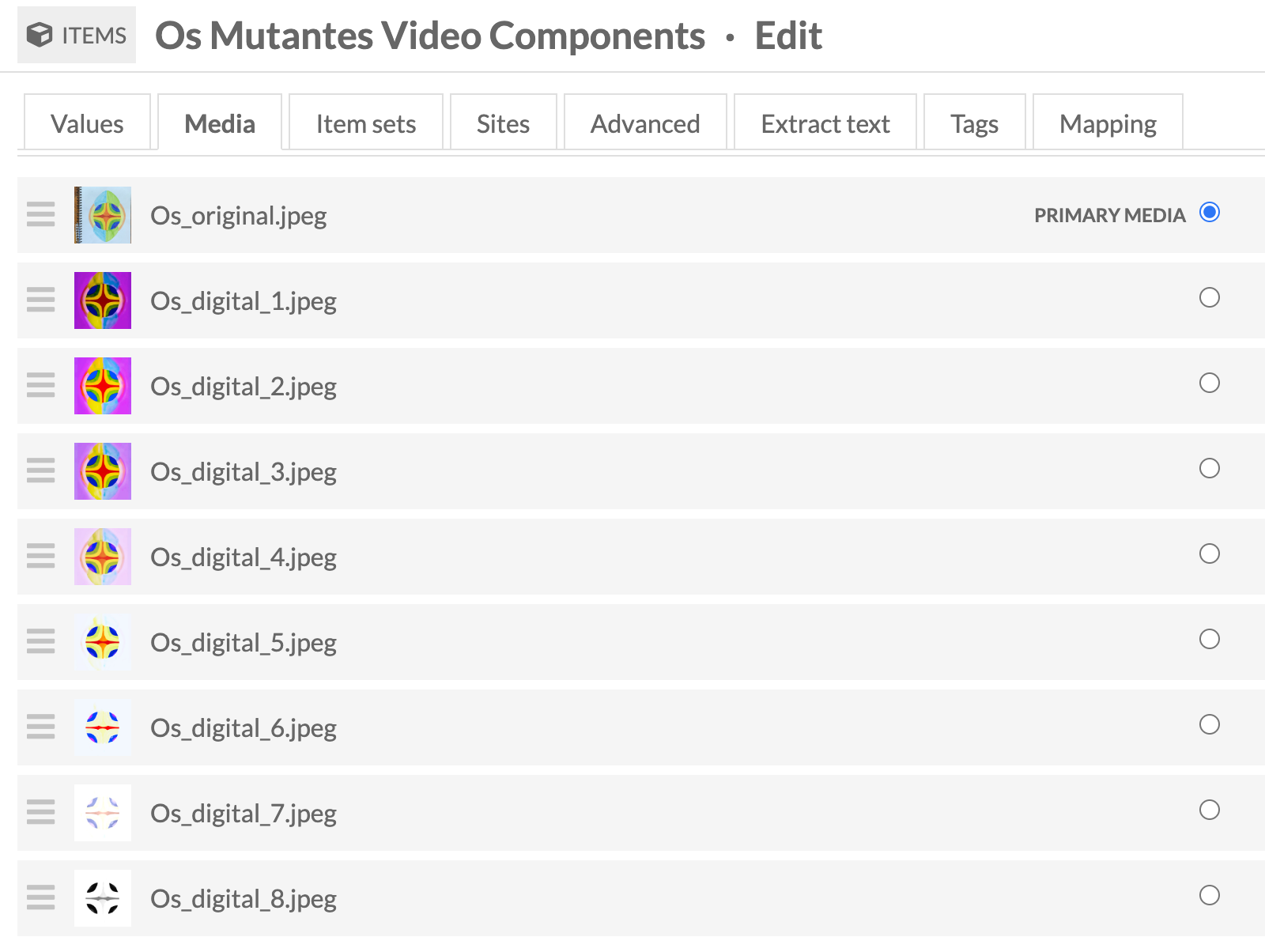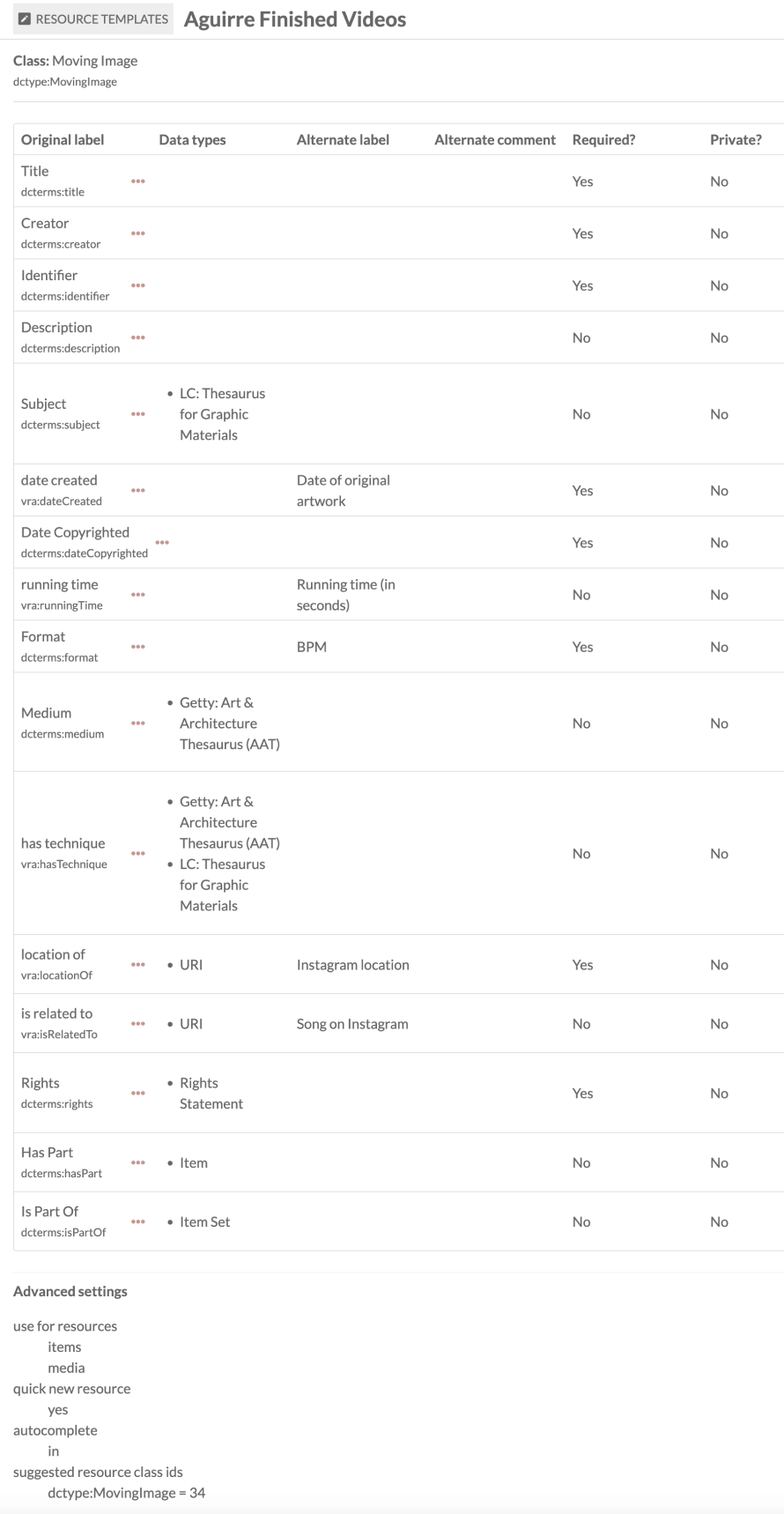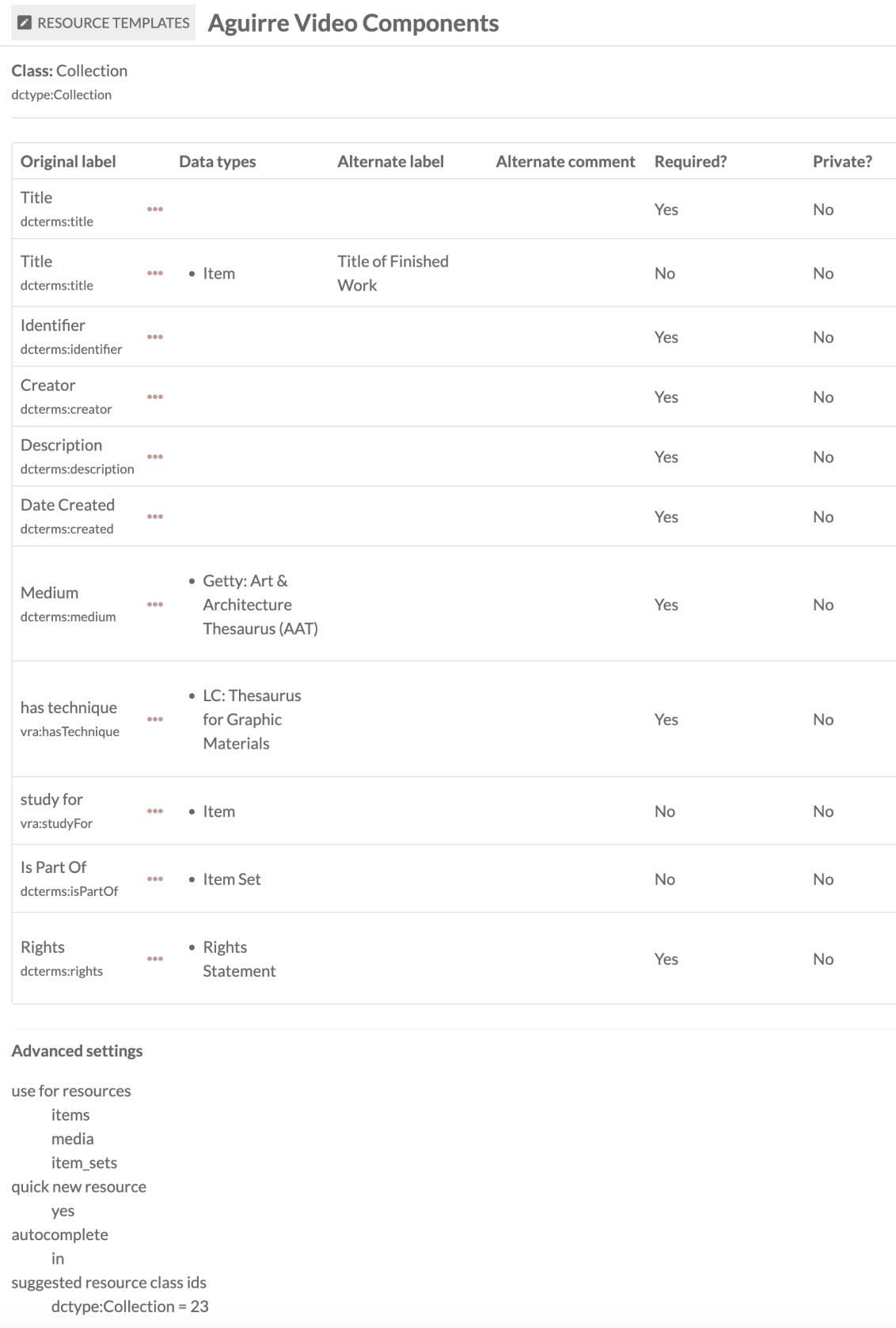PROJECT SCOPE AND METADATA
PROJECT SCOPE
I'm a Museums and Digital Culture M.S. graduate student at Pratt Institute's School of information. For my Museum Information Management semester project, I have chosen to catalog a selection of animation artworks I've made over the past few years and posted to Instagram.
I have catalogued both the animation video files as well as the source materials used to make the animations. Source materials include photographs of original static drawings made using a variety of materials, edited images and tiled images, animation cels, and intermediate video files.
This project has given me a few opportunities:
1. It allows me to organize the multitudes of files I have amassed in making animation videos in a methodical, logical way.
2. It allows me to learn how to catalog art object items and collections using Omeka S, metadata schema, and controlled vocabularies. These are skills I will use in my future work as a museum professional. By using my own artwork for this project, I have learned the basics I will employ in the future when cataloging objects, exhibitions, and source materials at cultural heritage institutions.
Museums, to different extents, have been digitally cataloging objects for a long time using various software systems. In 2020, when COVID forced the closure of physical museums, digitization of museum collections became paramount. First, it allowed museum professionals to track objects in physical and virtual spaces. Second, it allowed museums to interact with visitors without the limitation of physical proximity.
Museums share a common mission to serve the public. Developing and consistently updating well-documented systems for managing objects, collections, archives, and exhibitions aligns with this mission, both by sharing cultural heritage artifacts and their historical significance and by fostering diverse forms of public engagement.
3. It allows me to share my artistic practice in a place separate from Instagram with consideration and context. The art I make is very accessible, both in content and method. When we see art removed from context, hung in the grand (mostly white) halls of museums, it is both awe inspiring and intimidating.
I believe that the biggest hurdle in making art is overcoming the fear that an art practice is too difficult to adopt, requires inspiration and huge talent, is beyond the abilities of the average person, or that to make art, one must first be an artist.
In reality, the act of making art is what makes one an artist.
I want to dispel those myths. I use tools and materials that are widely available. My hope is to inspire anyone who comes here to see that art begins humbly and progresses through curiosity, wonder, experimentation, and persistence.
My artistic journey is ever evolving as I become more confident, keep developing my artistic voice, and build upon existing skills.
METADATA SCHEMA
For this project I used a combination of Dublin Core (DC) and Visual Resources Association (VRA) Core.
Dublin Core is an international metadata schema maintained by the Dublin Core Metadata Initiative (DMCI), an independent, public and nonprofit organisation. The Dublin Core schema is generally used to describe digital and physical resources.
DCMI consists of 15 elements (known as the Dublin Core Metadata Element Set) alongside ‘extension vocabularies’, which include dozens of properties, classes, data types and vocabulary encoding schemes.
VRA Core is used for describing ‘works of visual culture’ and the images that document them. Works of visual culture include both objects and events, such as paintings, drawings, sculptures, architecture, photographs, books and performance art.
The VRA Core is loosely based on the Dublin Core, and has grown from an original list of elements describing art and architectural images to a full data standard for describing images. The latest iteration (Core 4) is the only metadata schema designed specifically for describing images and related cultural objects. [Source]
CONTROLLED VOCABULARIES
For this project I used two sets of controlled vocabularies: the Library of Congress Thesaurus for Graphic Materials (LC) and the Getty Art and Architecutre Thesaurus (AAT).
The Thesaurus for Graphic Materials is a tool for indexing visual materials by subject and by genre/format. The thesaurus includes more than 7,000 subject terms and 650 genre/format terms to index types of photographs, prints, design drawings, ephemera, and other pictures. [Source]
The Getty Art and Architecture Thesaurus is a structured vocabulary, including terms, descriptions, and other metadata for generic concepts related to art, architecture, conservation, archaeology, and other cultural heritage. Included are work types, styles, materials, techniques, and others.
This controlled vocabulary may be used by someone cataloguing or indexing a collection as it provides preferred names or terms and synonyms for people, places, and things. It may also be helpful in retrieval of information from documentation systems and research into collections as it shows links and paths between concepts. [Source]
COMPLETE ITEM SET
This is my entire Item Set. It contains 10 animation video objects and 10 animation video source component collections. The animation videos have been catalogued separately from the source component collections.
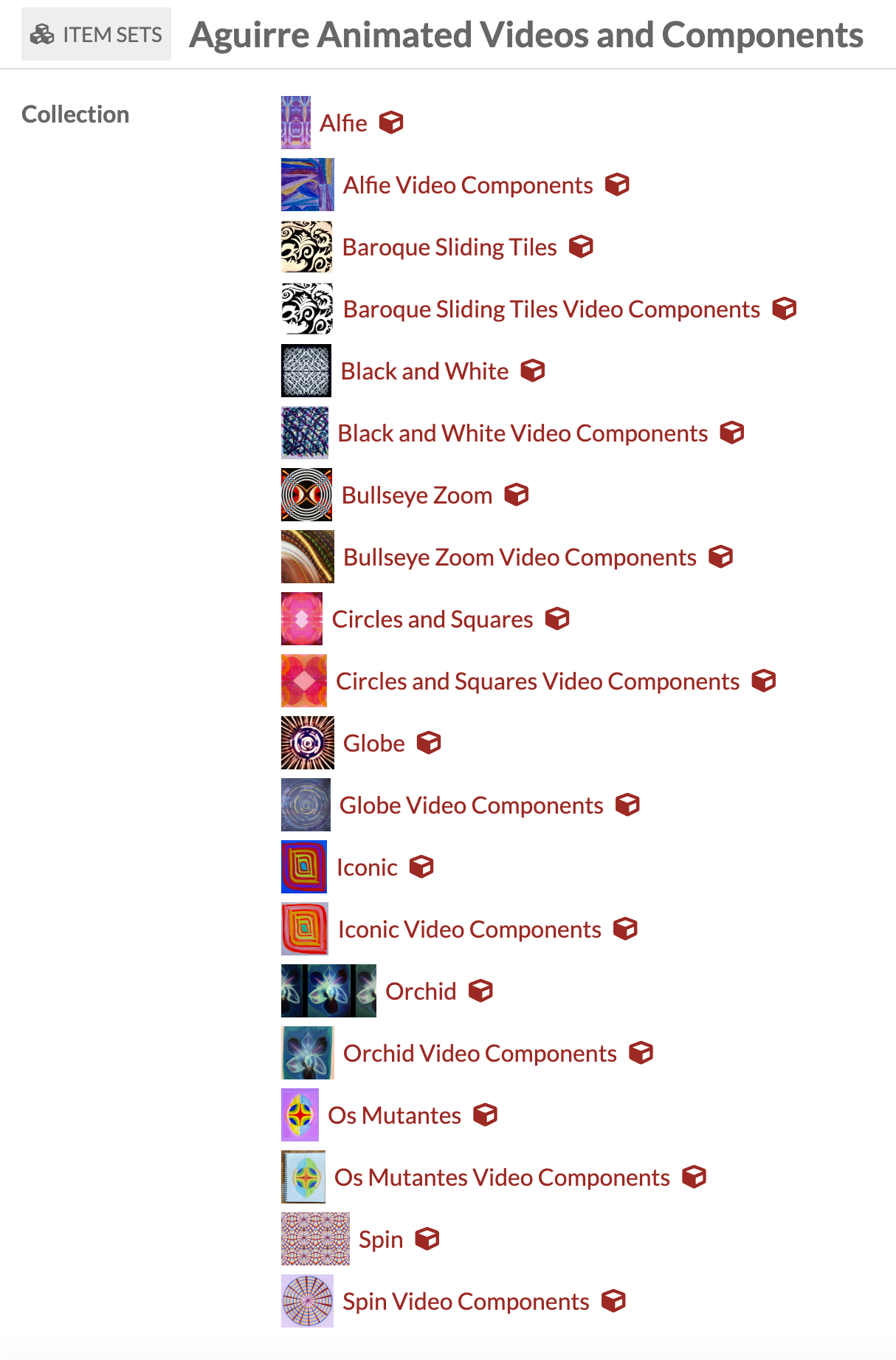
ANIMATION VIDEO RESOURCE TEMPLATE
The Finished Video Resource Template was created to support an item set of animation videos. In DC, videos are classified as "Moving Images". For this resource template I used both DC and VRA (where DC was not sufficient).
- Title (DC)
- Creator (DC)
- Identifier (DC): starts with "AFV_" and is numbered in order of item entry
- Description (DC): includes the name and type of the media file
- Subject (DC): Uses LC to describe the type of artworks
- Date of original artwork (originally DC "date created"): added to link the finished video back to the original physical object so I can go back to my files across computers and the cloud as necessary (year/month/date)
- Date Copyrighted (DC): used for legal purposes (year/month/date)
- Running time (in second) (originally "running time" in VRA): used to know how long the video is in case there are multiple versions of the same video
- BPM (originally "Format" in DC): used to catalog the inherent rhythm of a video in case the song it is currently linked to is no longer availabe on Instagram or I wish to pair the video with another song in the future
- Medium (DC): uses AAT to describe the type of medium used in the original artwork and the video
- Has Technique (VRA): uses both AAT and LC to describe techniques that are used in the original artwork an video but are not necessarily a "medium"
- Instagram location (originally VRA "location of"): a URI field that points to the published video's location on my Instagram account
- Song on Instagram (originally VRA "is related to"): a URI field that points to the song video on YouTube used with the video on Instagram
- Rights (DC): a Rights Statement field that indicates permission granted by the copyright holder to users
- Has Part (DC): an Item field that links the video to a source materials collection for navigatability
- Is Part of (DC): an Item Set field that links to the Aguirre Animated Videos and Components for navigability
OS MUTANTES CATALOGUED ANIMATION VIDEO
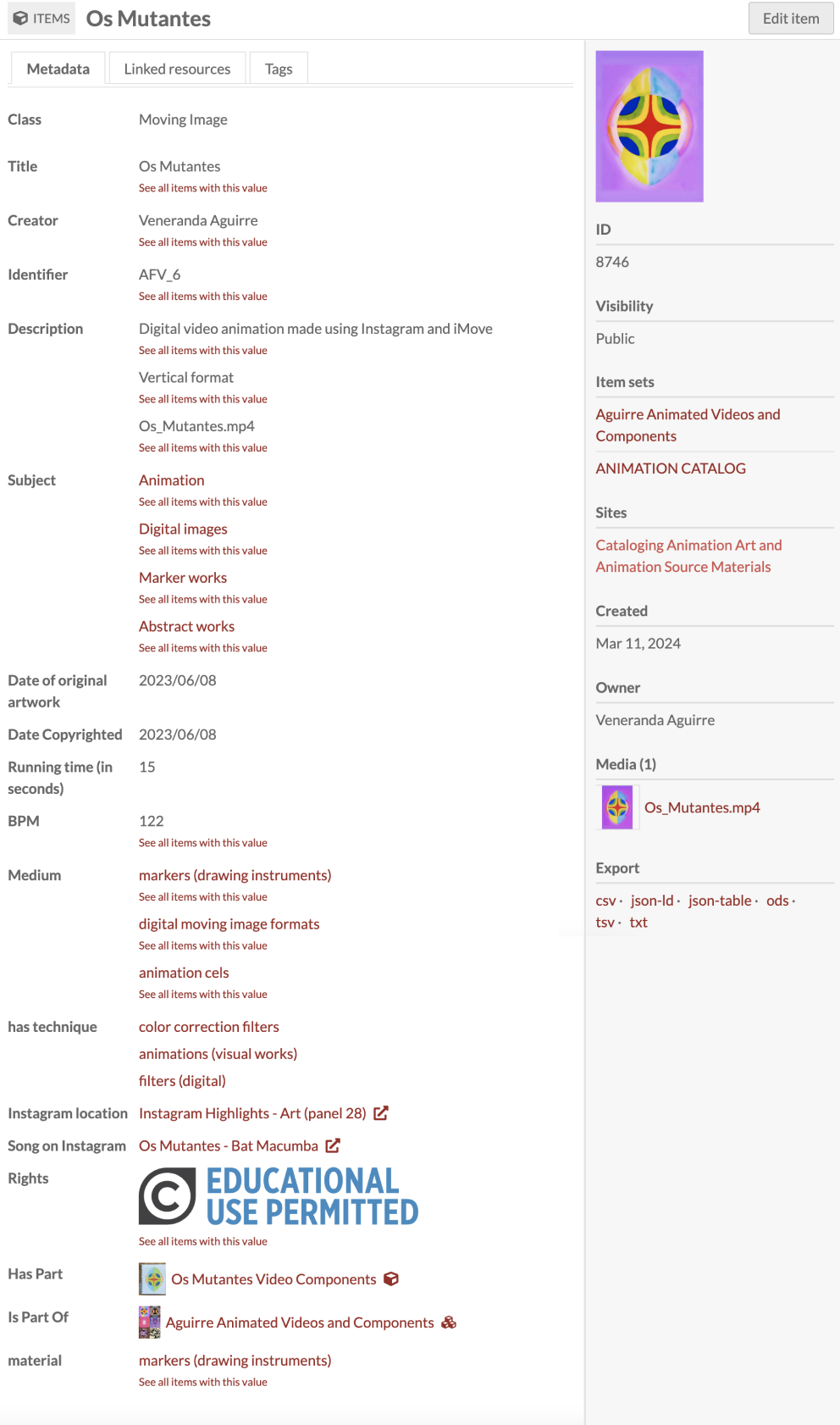
ANIMATION SOURCE MATERIALS COLLECTION RESOURCE TEMPLATE
The Video Components Resource Template was created to support an item set of source materials for finished videos. In DC, the class used for collections is called "Collection". For this resource template I used both DC and VRA (where DC was not sufficient).
- Title (DC)
- Title of Finished Work (originally DC Title): an Item field that links the collection to the finished video to which it pertains
- Identifier (DC): starts with "AVC_" and is numbered in order of item entry
- Creator (DC)
- Description (DC): includes the name and type of the media files
- Date created (DC): this field physical object so I can go back to my files across computers and the cloud as necessary (year/month/date)
- Medium (DC): uses AAT to describe the type of medium used in the original artwork and the video
- Has Technique (VRA): uses both AAT and LC to describe techniques that are used in the original artwork an video but are not necessarily a "medium"
- Study for (VRA): an Item field that links the source materials to the finished item for navigatability
- Is Part of (DC): an Item Set field that links to the Aguirre Animated Videos and Components for navigability
- Rights (DC): a Rights Statement field that indicates permission granted by the copyright holder to users
OS MUTANTES ANIMATION SOURCE MATERIALS COLLECTION
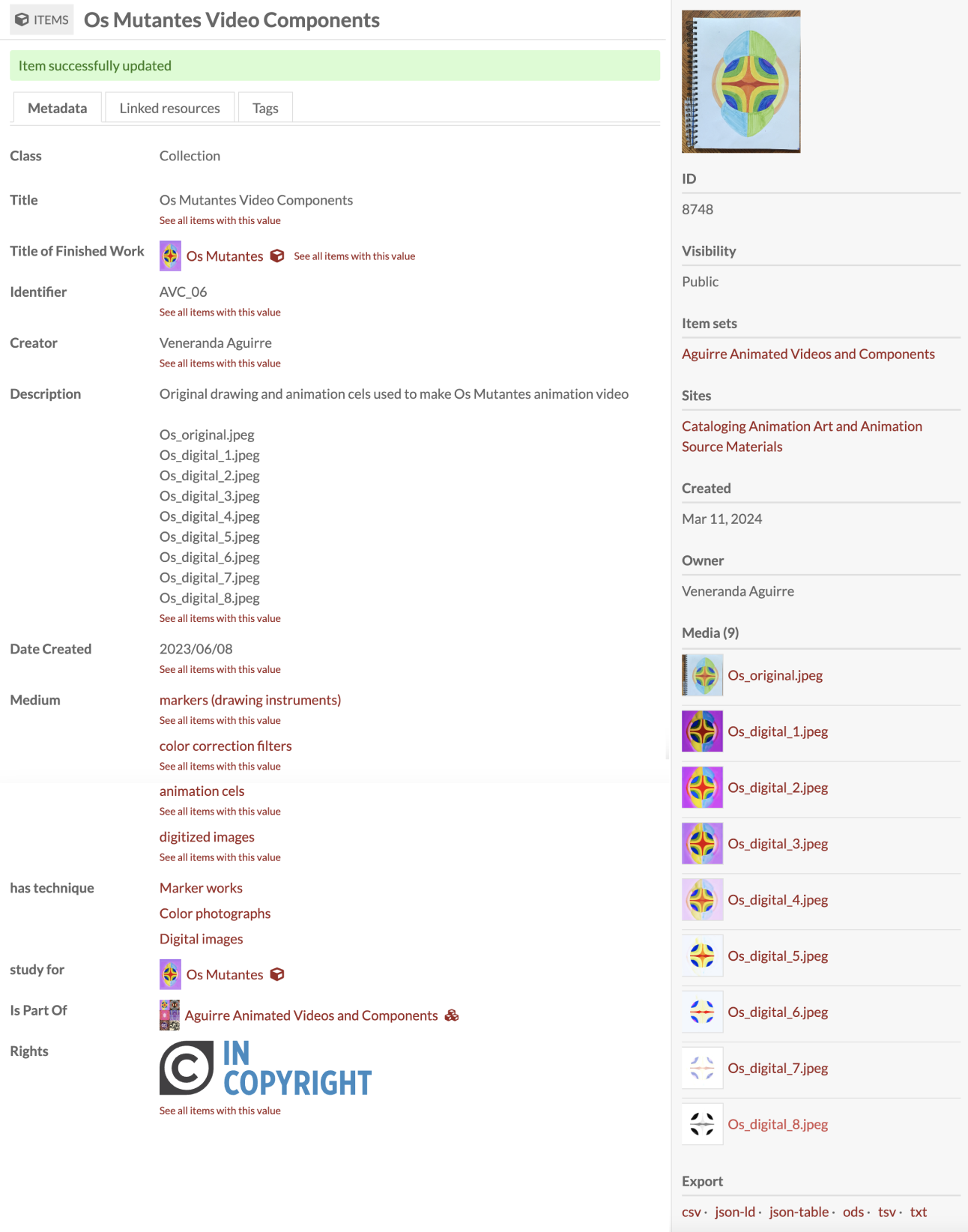
OS MUTANTES MEDIA LIBRARY
